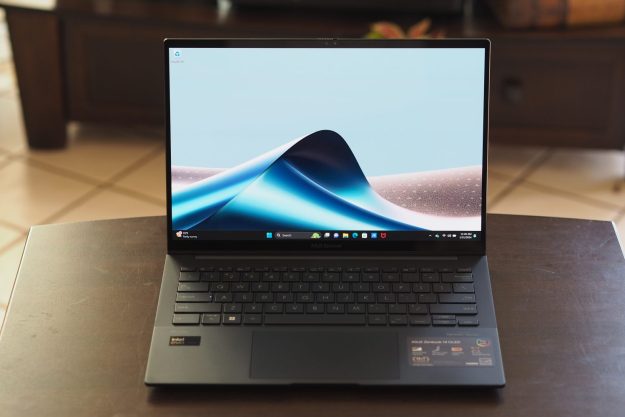The death of the PC was greatly exaggerated, but that argument was based on some basic truths. Computers have become a common part of our lives. They don’t excite as they used to (despite the innovations we saw in laptops this year) and many users just want a solid computing experience at the lowest price possible.
Desktops have accommodated this need for years, but only in the form of bulky and often ugly towers. This is arguably the real reason why laptops overtook desktops; many users don’t need the portability, but everyone appreciates sleek simplicity. At this year’s CES, though, we saw evidence that tiny desktops are ready to bust out of their niche and storm your office.
The NUC comes of age
Intel’s biggest computing announcement at CES 2015 was undoubtedly its Broadwell processor, but that was followed by the reveal of new Next Unit of Computing (NUC) models with fifth-generation Core processors. NUC is Intel’s push to make powerful but tiny desktops a reality, and it’s a rare example of a PC sold by Intel directly.
The new processor in the revised NUC has helped Intel shave the profile of the smallest model down to just a hair more than an inch thick. NUCs also hover around four and a half inches in width and length, so the whole package isn’t much larger than an Apple TV.
Yet performance remains strong. Even the slowest Core i3 model is more than capable of handling everyday tasks, and the quicker Core i5/i7 versions are downright powerful. They can’t hold a candle to a full-blown desktop Core i7 quad, of course, but they’re far more than sufficient even for video and image editing.

A look at NUC’s history reveals just how far Intel has come. The models available three years ago were about 50-percent thicker, yet had roughly 60-percent of the performance. Today’s models are truly capable of serving as an everyday machine, and not just for people with limited needs.
Yet in spite of their size, some customization is available. Users can replace the lids, removing the standard plastic cap for versions that add NFC, wireless charging, or a video adapter. These extra lids are not yet finalized, but they’re expected to become available in mid-2015.
Want smaller? Try the stick
NUC is small, but it’s still essentially a desktop. It needs to be placed somewhere and, unless you have a spare VESA mount, that somewhere is your desk. There are better options for living room PCs, point-of-sale systems and wall-mounted displays.
That’s where the Intel Compute Stick comes in. We first heard of it in November at the Intel Developer Forum, but the details were scarce. Now we know it’s planned for a March release at $149 with Windows 8.1 and a 32GB solid-state drive. Think about that for a moment. In March you can buy a full-blown Windows computer that connects to your display over HDMI for less than the price of most tablets.

Actually, you can kind of buy it now. CTL has its own Compute stick, which we’ve already reviewed. The difference, according to Intel, is that it offers active cooling, which allows upgraded models with Core processors rather than the Atom CPU that CTL’s is restricted to.
Whatever the specifications, the stick is impressive, and it’s a sign of things to come in the desktop space. Computers are becoming so small they simply slot into an HDMI port – or get bundled into a monitor to make for an extremely thin all-in-one.
It’s not just Intel
We’ve said a lot about Intel. Intel, Intel, Intel. It sounds great in theory, but let’s face it: Nothing with the Intel brand on it is going to become a consumer success. Everyone knows the company, but consumers aren’t comfortable buying products from it directly.
Ah, but it’s not just Intel anymore. One of HP’s big announcements was the Pavilion Mini and Stream Mini, a duo that brings small PCs into the mainstream. Surprisingly, neither uses the latest fifth-generation processors; instead they opt for older second- and third-generation models.
- 1. HP Stream Mini
- 2. HP Pavilion Mini
That’s probably why they’re larger than the NUC, but ultimately the fine details of the processor aren’t important. What’s important is HP’s recognizable brand and the price, which drops as low $179 for the base Stream Mini. Again, to be clear: That’s a full Windows 8.1 system for less than two Benjamin Franklins.
HP is only the most well known name in the mini-PC business. Asus, Gigabyte, Syber, and Zotac also showed some kind of tiny computer at CES 2015, and that’s just what we can talk about. Several other manufacturers hinted at or previewed prototype models that should come out in mid-2015.
Watch out for the tiny revolution
The tiny computers we saw at CES 2015 were essentially invisible. Once a NUC is set up there’s no reason to ever think about it again. It’s never in the way, never too loud, never too warm. Even repairs are unnecessary; if it breaks, just buy another. It’s only a couple hundred dollars, anyway.
This is a critical shift in the paradigm of computing. The barriers of space, power, and price are falling away in the face of wonderfully forgettable devices. Everyone can appreciate the simplicity of a PC that just works the moment it’s taken out of the box.
Enthusiast computers aren’t going anywhere, but drab, dull mid-tower rigs should be wary. The new wave of miniature PCs may render them extinct.
Editors' Recommendations
- The 5 best HP desktop PCs in 2024
- Intel’s 24-core laptop CPU might outclass desktop i9 processors
- Most of Intel’s new 12th-gen Alder Lake desktop chips ditch hybrid architecture




